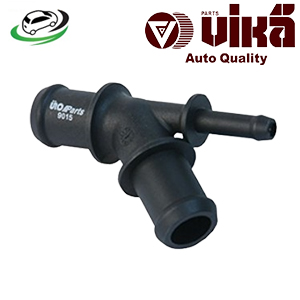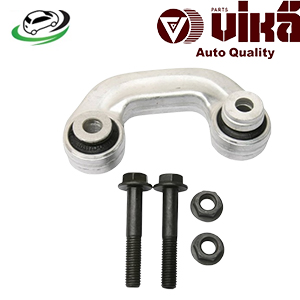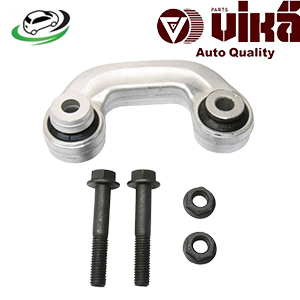-14%
Get Front Left Stabiliser Link Audi A4 S4/A6 S6/A6L/A6 Quattro/RS6 / VW Passat 1995-2005 8D0411317D
The stabilizer link, also known as the sway bar link, is a crucial component in a vehicle’s suspension system. It plays a significant role in maintaining stability and handling by connecting the stabilizer bar (sway bar) to the suspension components. This guide will explore what a stabilizer link is, how it functions, its benefits, common issues, and maintenance tips.
What is a Stabilizer Link?
The stabilizer link is a rod that connects the stabilizer bar to the suspension system of a vehicle. The stabilizer bar, also known as the sway bar, is a component of the vehicle’s suspension system designed to reduce body roll during cornering. The stabilizer link is typically made of metal and may include bushings and ball joints to allow for movement and flexibility.
How Does a Stabilizer Link Work?
The stabilizer link functions as a connecting rod between the stabilizer bar and the vehicle’s suspension system. Here’s a breakdown of its role and how it operates:
- Connection to Stabilizer Bar: The stabilizer link attaches to the stabilizer bar at one end. The stabilizer bar is mounted across the width of the vehicle and helps reduce body roll by transferring forces from one side of the vehicle to the other.
- Connection to Suspension Components: The other end of the stabilizer link connects to the suspension components, such as the control arms or struts. This linkage allows the stabilizer bar to interact with the suspension system.
- Reducing Body Roll: During cornering or uneven road conditions, the stabilizer bar works to counteract body roll by transferring the lateral forces from one side of the vehicle to the other. The stabilizer link ensures that the stabilizer bar can move freely and effectively.
- Flexibility and Movement: The stabilizer link includes bushings and ball joints that allow for movement and flexibility. This enables the stabilizer bar to adjust to different driving conditions while maintaining stability.
Benefits of a Properly Functioning Stabilizer Link
A properly functioning stabilizer link offers several important benefits for vehicle performance and handling:
- Enhanced Stability: By reducing body roll during cornering, the stabilizer link helps improve vehicle stability and handling. This enhances driver control and safety, particularly in sharp turns or during sudden maneuvers.
- Improved Ride Comfort: The stabilizer link helps maintain a level ride height and minimizes excessive bouncing or swaying. This contributes to a more comfortable driving experience, especially on uneven or rough roads.
- Reduced Tire Wear: Properly functioning stabilizer links help ensure even weight distribution and reduce the risk of excessive tire wear caused by uneven handling or alignment issues.
- Better Handling: With effective body roll control, the stabilizer link improves overall handling and responsiveness, making the vehicle more predictable and easier to control.
- Extended Suspension Life: By reducing stress on other suspension components, a well-maintained stabilizer link can help extend the lifespan of the suspension system and related parts.
Common Issues with Stabilizer Links
Over time, stabilizer links can experience various issues that may affect their performance and the overall suspension system. Common problems include:
- Wear and Tear: The bushings and ball joints in the stabilizer link can wear out due to regular use, leading to looseness or play in the link. This can affect handling and stability.
- Noise: Worn or damaged stabilizer links may produce clunking, banging, or squeaking noises, especially when driving over bumps or during cornering.
- Corrosion: Exposure to moisture and road salt can cause corrosion on the metal components of the stabilizer link, leading to rust and potential damage.
- Disconnected Links: In some cases, the stabilizer link may become disconnected from the stabilizer bar or suspension components, leading to a loss of stability and handling.
- Damaged Bushings: The bushings in the stabilizer link can become cracked, brittle, or degraded, reducing their effectiveness and leading to handling issues.
Signs of a Failing Stabilizer Link
Identifying the signs of a failing stabilizer link can help address issues before they lead to more severe suspension problems. Common symptoms include:
- Clunking or Rattling Noises: Unusual noises, such as clunking or rattling, coming from the suspension area while driving can indicate a problem with the stabilizer link.
- Excessive Body Roll: Increased body roll during cornering or turns can be a sign of a worn or damaged stabilizer link, affecting the vehicle’s stability.
- Squeaking or Grinding Sounds: Squeaking or grinding noises when driving over bumps or rough surfaces may indicate worn bushings or ball joints in the stabilizer link.
- Uneven Tire Wear: If you notice uneven tire wear or handling issues, it could be related to a problem with the stabilizer link affecting the vehicle’s alignment.
- Loose or Wobbly Steering: A failing stabilizer link can cause loose or wobbly steering, making the vehicle feel less responsive and less stable.
Maintenance and Replacement
Regular maintenance and timely replacement of stabilizer links are essential for ensuring optimal vehicle handling and safety. Here are some maintenance tips:
- Regular Inspections: Periodically inspect the stabilizer links for signs of wear, damage, or corrosion. Check for any unusual noises or looseness in the suspension system.
- Listen for Noise: Pay attention to any clunking or squeaking noises while driving. These noises can be indicators of worn or damaged stabilizer links.
- Replace Worn Components: If the stabilizer link shows signs of wear, damage, or noise, replace it with a high-quality part that meets or exceeds the manufacturer’s specifications.
- Check for Proper Installation: Ensure that stabilizer links are properly installed and securely fastened. Improper installation can lead to handling issues and potential safety concerns.
- Professional Inspection: If you suspect a problem with the stabilizer link or the suspension system, have a professional mechanic inspect the vehicle for a thorough diagnosis and repair.
Replacement Procedure
Replacing a stabilizer link typically involves the following steps:
- Preparation: Ensure the vehicle is on a level surface and that the suspension is supported with jack stands. Gather the necessary tools and a replacement stabilizer link.
- Locate the Stabilizer Link: Identify the location of the stabilizer link. It is usually connected to the stabilizer bar and the suspension components.
- Remove the Old Link: Use appropriate tools to remove the bolts or fasteners securing the old stabilizer link. Carefully detach the link from the stabilizer bar and suspension components.
- Install the New Link: Position the new stabilizer link in place and secure it with the appropriate bolts or fasteners. Ensure that the link is properly aligned and tightened.
- Check for Proper Fit: Verify that the new stabilizer link is correctly installed and that there is no excessive play or looseness. Ensure that all fasteners are properly tightened.
- Test Drive: Take the vehicle for a test drive to ensure that the suspension system is functioning correctly and that there are no unusual noises or handling issues.
Follow us on Facebook for more parts.



